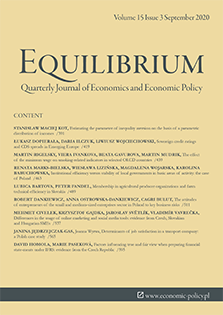Estimating the parameter of inequality aversion on the basis of a parametric distribution of incomes
Estimating the parameter of inequality aversion on the basis of a parametric distribution of incomes
Author(s): Stanisław Maciej KotSubject(s): Micro-Economics, Welfare systems, Methodology and research technology, Welfare services, Economic development
Published by: Instytut Badań Gospodarczych
Keywords: income inequality; inequality aversion; estimation; income distribution;
Summary/Abstract: Research background: In applied welfare economics, the constant relative inequality aversion function is routinely used as the model of a social decisionmaker’s or a society’s preferences over income distributions. This function is entirely determined by the parameter, ε, of inequality aversion. However, there is no authoritative answer to the question of what the range of ε an analyst should select for empirical work. Purpose of the article: The aim of this paper is elaborating the method of deriving ε from a parametric distribution of disposable incomes. Methods: We assume that households’ disposable incomes obey the generalised beta distribution of the second kind GB2(a,b,p,q). We have proved that, under this assumption, the social welfare function exists if and only if ε belongs to (0,ap+1) interval. The midpoint εmid of this interval specifies the inequality aversion of the median social-decisionmaker. Findings & Value added: The maximum likelihood estimator of εmid has been developed. Inequality aversion for Poland 1998–2015 has been estimated. If inequality is calculated on the basis of disposable incomes, the standard inequality–development relationship might be complemented by inequality aversion. The “augmented” inequality–development relationship reveals new phenomena; for instance, the stage of economic development might matter when assessing the impact of inequality aversion on income inequality.
Journal: Equilibrium. Quarterly Journal of Economics and Economic Policy
- Issue Year: 15/2020
- Issue No: 3
- Page Range: 391-417
- Page Count: 27
- Language: English

